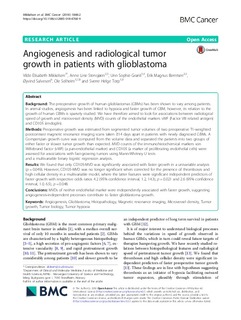| dc.contributor.author | Mikkelsen, Vilde Elisabeth | |
| dc.contributor.author | Stensjøen, Anne Line | |
| dc.contributor.author | Granli, Unn Sophie | |
| dc.contributor.author | Berntsen, Erik Magnus | |
| dc.contributor.author | Salvesen, Øyvind | |
| dc.contributor.author | Solheim, Ole | |
| dc.contributor.author | Torp, Sverre Helge | |
| dc.date.accessioned | 2018-09-06T07:37:58Z | |
| dc.date.available | 2018-09-06T07:37:58Z | |
| dc.date.created | 2018-09-04T16:35:12Z | |
| dc.date.issued | 2018 | |
| dc.identifier.citation | BMC Cancer. 2018, 18 (1), 862-?. | nb_NO |
| dc.identifier.issn | 1471-2407 | |
| dc.identifier.uri | http://hdl.handle.net/11250/2561105 | |
| dc.description.abstract | Background
The preoperative growth of human glioblastomas (GBMs) has been shown to vary among patients. In animal studies, angiogenesis has been linked to hypoxia and faster growth of GBM, however, its relation to the growth of human GBMs is sparsely studied. We have therefore aimed to look for associations between radiological speed of growth and microvessel density (MVD) counts of the endothelial markers vWF (Factor VIII related antigen) and CD105 (endoglin).
Methods
Preoperative growth was estimated from segmented tumor volumes of two preoperative T1-weighted postcontrast magnetic resonance imaging scans taken ≥14 days apart in patients with newly diagnosed GBMs. A Gompertzian growth curve was computed from the volume data and separated the patients into two groups of either faster or slower tumor growth than expected. MVD counts of the immunohistochemical markers von Willebrand factor (vWF) (a pan-endothelial marker) and CD105 (a marker of proliferating endothelial cells) were assessed for associations with fast-growing tumors using Mann-Whitney U tests and a multivariable binary logistic regression analysis.
Results
We found that only CD105-MVD was significantly associated with faster growth in a univariable analysis (p = 0.049). However, CD105-MVD was no longer significant when corrected for the presence of thromboses and high cellular density in a multivariable model, where the latter features were significant independent predictors of faster growth with respective odds ratios 4.2 (95% confidence interval, 1.2, 14.3), p = 0.021 and 2.6 (95% confidence interval, 1.0, 6.5), p = 0.048.
Conclusions
MVDs of neither endothelial marker were independently associated with faster growth, suggesting angiogenesis-independent processes contribute to faster glioblastoma growth. | nb_NO |
| dc.language.iso | eng | nb_NO |
| dc.publisher | BMC (part of Springer Nature) | nb_NO |
| dc.rights | Navngivelse 4.0 Internasjonal | * |
| dc.rights.uri | http://creativecommons.org/licenses/by/4.0/deed.no | * |
| dc.title | Angiogenesis and radiological tumor growth in patients with glioblastoma | nb_NO |
| dc.type | Journal article | nb_NO |
| dc.type | Peer reviewed | nb_NO |
| dc.description.version | publishedVersion | nb_NO |
| dc.source.pagenumber | 862-? | nb_NO |
| dc.source.volume | 18 | nb_NO |
| dc.source.journal | BMC Cancer | nb_NO |
| dc.source.issue | 1 | nb_NO |
| dc.identifier.doi | 10.1186/s12885-018-4768-9 | |
| dc.identifier.cristin | 1606706 | |
| dc.description.localcode | © The Author(s). 2018 Open Access This article is distributed under the terms of the Creative Commons Attribution 4.0 International License (http://creativecommons.org/licenses/by/4.0/) | nb_NO |
| cristin.unitcode | 194,65,15,0 | |
| cristin.unitcode | 194,65,25,0 | |
| cristin.unitcode | 194,65,1,0 | |
| cristin.unitcode | 194,65,30,0 | |
| cristin.unitname | Institutt for klinisk og molekylær medisin | |
| cristin.unitname | Institutt for sirkulasjon og bildediagnostikk | |
| cristin.unitname | MH fakultetsadministrasjon | |
| cristin.unitname | Institutt for nevromedisin og bevegelsesvitenskap | |
| cristin.ispublished | true | |
| cristin.fulltext | original | |
| cristin.qualitycode | 1 | |

